Shallow M5.8 earthquake hits Oklahoma, state’s strongest earthquake ever
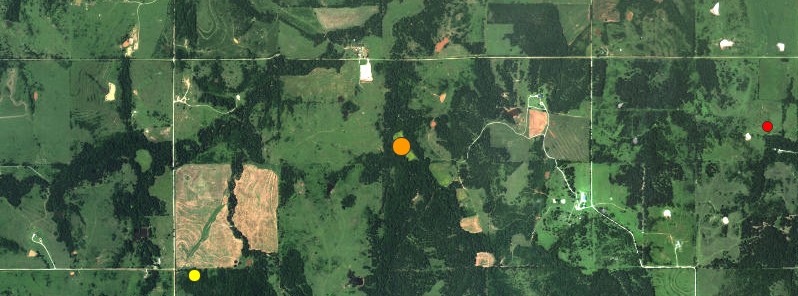
A strong and shallow earthquake registered by the USGS as Mw5.8 hit 15 km (9.3 miles) northwest of Pawnee, north-central Oklahoma at 12:02 UTC on September 3, 2016. The agency reported a depth of 5.4 km (3.3 miles). Between September 1 and 3, USGS registered a total of 6 earthquakes in this area.
Although no major damage was immediately reported, today's quake is Oklahoma's strongest earthquake on record. Initially, it was recorded as Mw5.6, but the agency upgraded the magnitude to Mw5.8 on September 7.
At the same time, the USGS upgraded the November 5, 2011 earthquake which hit near Prague at a depth of 5 km (3.1 miles) from Mw5.6 to Mw5.7, making it the second largest earthquake to hit Oklahoma. Before the September 3 earthquake, it was considered the strongest quake to hit the state ever. The epicenter of that earthquake was in the vicinity of several active hydraulic fracturing wastewater injection wells. The previous record was a 5.5 magnitude earthquake that struck near the town of El Reno in 1952.
Beginning in 2009, the frequency of earthquakes in the State of Oklahoma rapidly increased from an average of less than two 3.0+ Mw earthquakes per year to hundreds in 2014 and 2015. Thousands of earthquakes have occurred in Oklahoma and surrounding areas in southern Kansas and North Texas since 2009 and scientific studies attribute the rise in earthquakes to the disposal of saltwater produced during oil extraction that has been injected more deeply into the ground.
Some parts of Oklahoma now match northern California for the nation's most shake-prone.
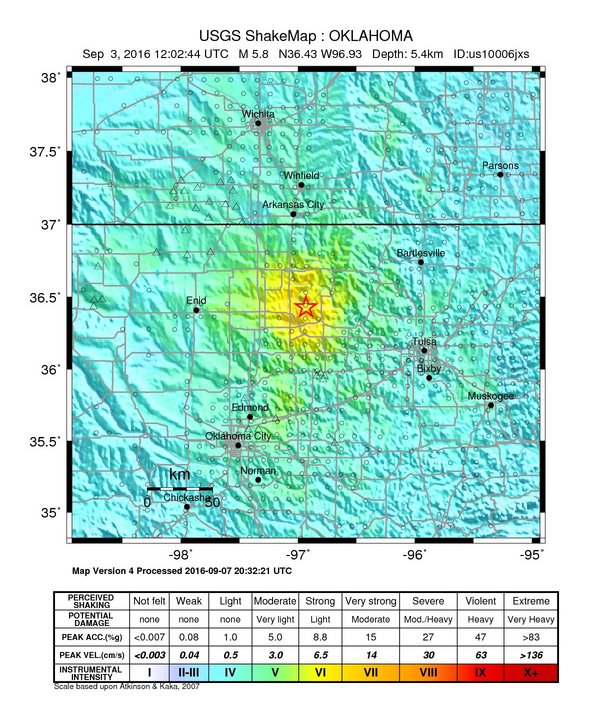
USGS issued a green alert for shaking-related fatalities and economic losses. There is a low likelihood of casualties and damage
Overall, the population in this region resides in structures that are resistant to earthquake shaking, though some vulnerable structures exist.
Estimated population exposure to earthquake shaking
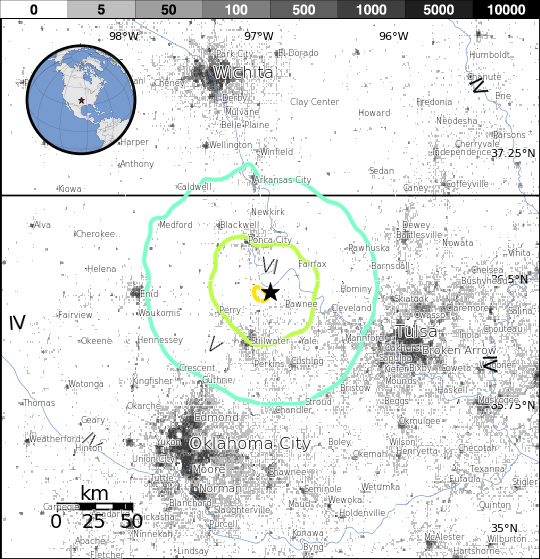
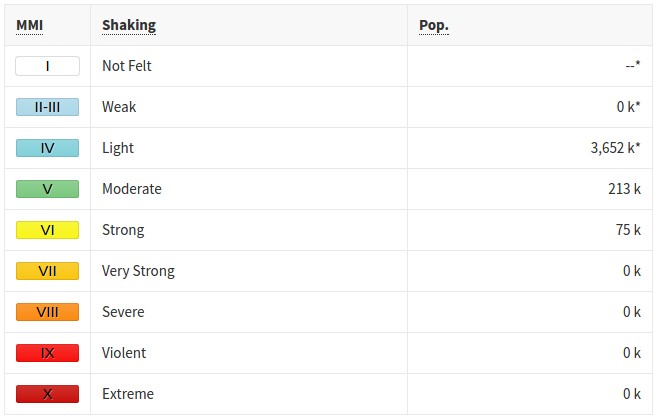
Selected cities exposed
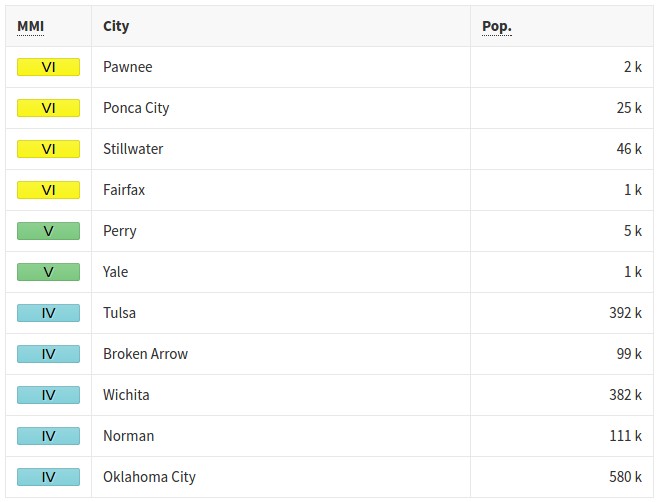
Take a closer look at this region
Earthquakes in the stable continental region by USGS
Natural occurring earthquake activity
Most of North America east of the Rocky Mountains has infrequent earthquakes. Here and there earthquakes are more numerous, for example in the New Madrid seismic zone centered on southeastern Missouri, in the Charlevoix-Kamouraska seismic zone of eastern Quebec, in New England, in the New York – Philadelphia – Wilmington urban corridor, and elsewhere. However, most of the enormous region from the Rockies to the Atlantic can go years without an earthquake large enough to be felt, and several U.S. states have never reported a damaging earthquake.
Earthquakes east of the Rocky Mountains, although less frequent than in the West, are typically felt over a much broader region than earthquakes of similar magnitude in the west. East of the Rockies, an earthquake can be felt over an area more than ten times larger than a similar magnitude earthquake on the west coast. It would not be unusual for a magnitude 4.0 earthquake in eastern or central North America to be felt by a significant percentage of the population in many communities more than 100 km (60 mi) from its source. A magnitude 5.5 earthquake in eastern or central North America might be felt by much of the population out to more than 500 km (300 mi) from its source. Earthquakes east of the Rockies that are centered in populated areas and large enough to cause damage are, similarly, likely to cause damage out to greater distances than earthquakes of the same magnitude centered in western North America.
Most earthquakes in North America east of the Rockies occur as faulting within bedrock, usually miles deep. Few earthquakes east of the Rockies, however, have been definitely linked to mapped geologic faults, in contrast to the situation at plate boundaries such as California's San Andreas fault system, where scientists can commonly use geologic evidence to identify a fault that has produced a large earthquake and that is likely to produce large future earthquakes. Scientists who study eastern and central North America earthquakes often work from the hypothesis that modern earthquakes occur as the result of slip on preexisting faults that were formed in earlier geologic eras and that have been reactivated under the current stress conditions. The bedrock of Eastern North America is, however, laced with faults that were active in earlier geologic eras, and few of these faults are known to have been active in the current geologic era. In most areas east of the Rockies, the likelihood of future damaging earthquakes is currently estimated from the frequencies and sizes of instrumentally recorded earthquakes or earthquakes documented in historical records.
Induced seismicity
As is the case elsewhere in the world, there is evidence that some central and eastern North America earthquakes have been triggered or caused by human activities that have altered the stress conditions in earth's crust sufficiently to induce faulting. Activities that have induced felt earthquakes in some geologic environments have included impoundment of water behind dams, injection of fluid into the earth's crust, extraction of fluid or gas, and removal of rock in mining or quarrying operations. In much of eastern and central North America, the number of earthquakes suspected of having been induced is much smaller than the number of natural earthquakes, but in some regions, such as the south-central states of the U.S., a significant majority of recent earthquakes are thought by many seismologists to have been human-induced. Even within areas with many human-induced earthquakes, however, the activity that seems to induce seismicity at one location may be taking place at many other locations without inducing felt earthquakes. In addition, regions with frequent induced earthquakes may also be subject to damaging earthquakes that would have occurred independently of human activity. Making a strong scientific case for a causative link between a particular human activity and a particular sequence of earthquakes typically involves special studies devoted specifically to the question. Such investigations usually address the process by which the suspected triggering activity might have significantly altered stresses in the bedrock at the earthquake source, and they commonly address the ways in which the characteristics of the suspected human-triggered earthquakes differ from the characteristics of natural earthquakes in the region.
Featured image credit: USGS

Commenting rules and guidelines
We value the thoughts and opinions of our readers and welcome healthy discussions on our website. In order to maintain a respectful and positive community, we ask that all commenters follow these rules.